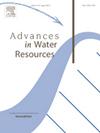A Modeling framework for flocculated cohesive sediment transport in the current bottom boundary layer
IF 4
2区 环境科学与生态学
Q1 WATER RESOURCES
引用次数: 0
Abstract
Cohesive sediment transport, where its settling velocity is controlled by the flocculation process, is a crucial component in determining biochemical cycles, fate of pollutants, and morphodynamics in many aquatic ecosystems. In this study, a modeling framework is presented to investigate how flocculation influences cohesive sediment transport in the current bottom boundary layer in dilute conditions, consistent with the calibration range of the flocculation model. From a local analysis of floc dynamics in homogenous turbulence, we identify that the floc size distribution is mainly controlled by floc cohesion and yield strength. The uncertainty in fractal dimension plays a minor role for the floc size but it influences the resulting floc density and settling velocity. The transport analysis in the current boundary layer shows that the flocculation process alters the vertical distribution of the settling velocity and hence the sediment concentration with a strong dependence on cohesion, floc yield strength, and floc structure. When the flocs are more susceptible to breaking, a well-mixed concentration profile is obtained. In contrast, for flocs with higher cohesion or yield strength, higher concentration with a sharp gradient is observed close to the bed. Overall, the settling velocity exhibits a low vertical variability within 20 % of the depth-averaged value except near the bed. This suggests that using a depth-averaged settling velocity yields acceptable predictions of the sediment concentration profiles, especially for flocs with lower cohesion.
求助全文
约1分钟内获得全文
求助全文
来源期刊

Advances in Water Resources
环境科学-水资源
CiteScore
9.40
自引率
6.40%
发文量
171
审稿时长
36 days
期刊介绍:
Advances in Water Resources provides a forum for the presentation of fundamental scientific advances in the understanding of water resources systems. The scope of Advances in Water Resources includes any combination of theoretical, computational, and experimental approaches used to advance fundamental understanding of surface or subsurface water resources systems or the interaction of these systems with the atmosphere, geosphere, biosphere, and human societies. Manuscripts involving case studies that do not attempt to reach broader conclusions, research on engineering design, applied hydraulics, or water quality and treatment, as well as applications of existing knowledge that do not advance fundamental understanding of hydrological processes, are not appropriate for Advances in Water Resources.
Examples of appropriate topical areas that will be considered include the following:
• Surface and subsurface hydrology
• Hydrometeorology
• Environmental fluid dynamics
• Ecohydrology and ecohydrodynamics
• Multiphase transport phenomena in porous media
• Fluid flow and species transport and reaction processes
 求助内容:
求助内容: 应助结果提醒方式:
应助结果提醒方式:


